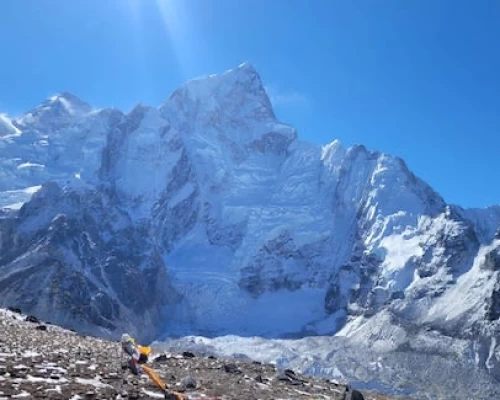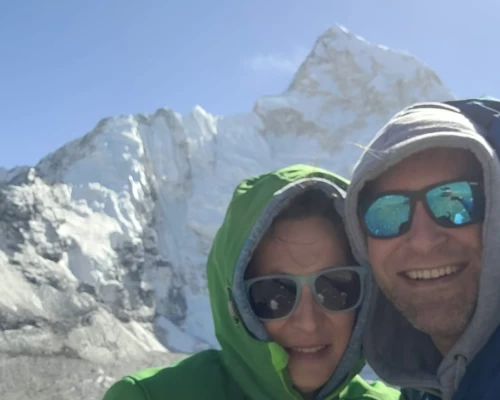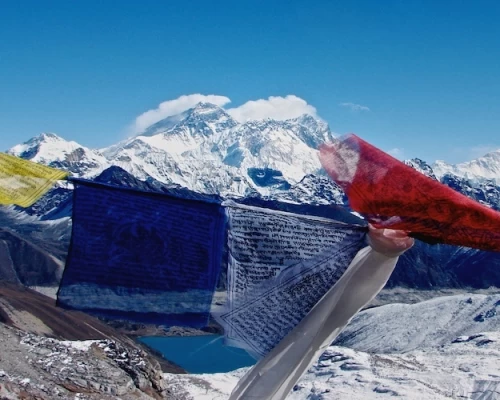12 Days Everest Base Camp Trek is Adventurers and adrenaline junkies worldwide are drawn to Mount Everest because of its towering summit. Many people join us on this 12-day guided adventure journey as we head to the world's tallest mountain base camp. Fly to Lukla Airport from Kathmandu, then take the trail that runs alongside the Dudh Koshi River's raging banks. Everest Base Camp is one of the most popular treks in the world. The 12-day Everest Base Camp trek will take you through some of the most stunning scenery in the world. You'll see up close the tallest mountains in the world, including Mount Everest. You'll also get to experience the culture of Nepal, meet friendly locals, and enjoy delicious Nepalese food. This trek is perfect for those who love hiking and being outdoors. It's also a great way to challenge yourself and push your limits.
If you're looking for an adventure of a lifetime, look no further than the 12-day Everest base camp trek. This group trekking experience takes you through some of the world's most beautiful and majestic scenery. You'll trek through September when the weather is perfect for hiking and May when the flowers bloom. Feel privileged if you are planning to journey this time. Fewer people will be around, and you'll spend more time in nature. The entire route will be yours! Spring is also a great time to go, as the Nepal countryside is blanketed in a beautiful green hue. Everyone enjoys spring. The mountains come to life in the spring, when the greenery blooms, the rhododendrons bloom, and all the animals emerge from hiding, especially if you are a trekker to Nepal. You would not want to miss the advantage of not traveling to the Everest Base Camp in May, as it is the final month of this magnificent Nepali spring. Your hiking trip in May will be enhanced by the numerous other travelers you'll encounter.
Trekkers can enjoy the clearest views when the weather is stable, and there are sunny days with a deep blue sky in October too. Clouds may occasionally obscure the view of snow-capped summits in the late afternoon. If not, you can see the region's countryside, mountains, and natural beauty. The nice weather makes the trek to Everest Base Camp in October more enjoyable. In contrast to the winter nights, the Everest region experiences bearable cold in October. In the Everest Base Camp, November marks the end of the hiking season. Another best trekking month in Everest is autumn, which lasts from September to November. This is also the last month before the winter season in the Everest region begins.
Everest Base Camp Trek is an incredible journey that takes you deep into the Nepalese Himalayas. The trek is a challenging but rewarding journey of around 12 days and covers more than 120 miles. Spring is also a great time to go, as the Nepal countryside is blanketed in a beautiful green hue. The winter is passed, and the sun is appreciated. This is how March comes into the light. Everest Base Camp in March is more pleasant due to the nice weather. The plants bloom, and those who come to trek and help you along the road are often happier.
Along with March, April also marks the beginning of the days getting longer, giving you plenty of time to enjoy and document the memories you make while on your Everest Base Camp trek in April. Moreover, due to off-the-beaten-path treks, long and tedious journeys, unsafe trails, and dangerous dense forest walking, single-solo trekking in the Himalayas may be more challenging than group one. When hiking there are several factors to consider including security, weather, wildlife, and injuries. When you walk in a group, you have protection in case an accident happens. However, traveling to the Everest base camp trek in a group makes the Everest Base Camp Trek safe, simple, enjoyable, and joyful.
Everest Base Camp Trekking offers a significant involvement with broad perspectives of the absolute most impressive and lovely mountains globally. Trekkers say Everest Base Camp is among the most inspiring places. As you meet upbeat trekkers along the way and see profoundly energetic mountaineers getting ready to climb Mount Everest, you get the vitality to finish your trek. Mount Everest is known as Chomolungma in the Tibetan language. It means, ‘Mother Goddess of the Snows”. Everest is the star of the Himalayas and an irresistible lure to adventurers far and wide. No place is more strongly associated with MTS than Nepal since it is here that we laid the cornerstone of our passion for adventure in the late 1960s by organizing the first commercial treks in the country. 12 Days Everest Base Camp Trek is the Trending Everest trekking package.
Everest base camp trekking journey takes you to the foot of Everest, revealing the extravagant fantastic thing about the region on the means. You will 1st visit pleasant Nepal villages throughout the Everest base camp, trekking wherever you’ll meet friendly individuals, take in the colors, sights, and sounds of village life, and revel in stays at Sherpa-run lodges. Then you’ll head to the rocky heights of Kala Patar (5545m), where you’ll set your eyes on the remarkable face of Everest and trek to Base Camp, with its views 50-foot-tall. Everest base camp touring The experience of adventures and bravery. Alternatively, you can choose the Everest 3 high pass trek too.
What to Expect From the Mt. Everest Base Camp Trek?
- 360-degree view of the Himalayas from Kala Patthar (5,643 m)
- The best seasons and months for Everest Base Camp Trek are Spring and autumn (March-May & September-December).
- The trail passes through Dudh Koshi Valley, Phakding, Pheriche, Namche Bazaar, and more.
- Sherpa people are generally friendly, hospitable, and laid-back, yet they can occasionally become intolerant if you treat them with disrespect.
- Although the food and lodging on the hike to Everest Base Camp are simple, they are more than sufficient.
- Your adventure's physical aches and pains will soon go away, but you'll have a treasure trove of unforgettable memories instead.
12 Days Everest base camp trek Highlights
- Buddhist monasteries in Namche, Khumjung, Tengboche and Panboche.
- Massive views of Ama Dablam from Mugla Pass
- Sunrise views from Kalapathar with Mt Everest, Pumori, Nuptse, Lhotse, and many more
- View of Khumbu Icefall and glacier
- Spend two nights at Namche Bazaar, the bustling market town in the heart of Sherpa country
- Spend several days through the homelands of the Sherpa people
12 Days Everest base camp trek Price in a group
Groups of five or more individuals are often seen joining together to partake in the experience of trekking in Nepal, traversing the majestic Himalayas during their journey. It is a popular vacation activity, allowing individuals to explore the area's nature and culture while interacting with the locals and other visitors. Such experiences are full of adventure and will likely create a lifetime of memories. Spiritual well-being and confidence levels are improved by solo trekking since you can overcome obstacles on your own. However, it is impossible to deny that group hiking is more enjoyable and accessible because there is support. Let's face it, the larger the group, the cheaper the package price is due to shared logistics. Likewise,s when the group moves forward efficiently and cooperatively, everything turns out the best. And that occurs when the team's strength is within a controlled range. The power of a group is its preparation, planning, and punctuality. Members become mentally and emotionally prepared by gaining hands-on experience in an unfamiliar environment.
It is a good time for everyone, especially the solo traveler looking for a group to join the trek and climb in Nepal. It is an opportunity for solo travelers to meet people from other countries and share their culture, nature, landscapes, and previous travel experiences with others. You can choose popular group joining trekking and peak climbing packages like Annapurna base camp trek, Lobuche east peak climbs, Langtang Valley trek, and Manaslu circuit trek if you are interested. There are a lot of costs associated with Everest Base Camp in Nepal. When it comes to the price of a trek, there are three things you need to consider: the cost of the trek itself, the cost of equipment, and the cost of permits.
Cost of 12-Day Everest Base Camp | 1-1 pax | 2-4 Pax | 5-10 Pax | 11-20 Pax | |
|---|---|---|---|---|---|
JANUARY | US $ 1400 | US $ 1350 | US $ 1300 | US $ 1175 | |
FEBRUARY | US $ 1400 | US $ 1350 | US $ 1300 | US $ 1175 | |
MARCH | US $ 1400 | US $ 1350 | US $ 1300 | US $ 1175 | |
APRIL | US $ 1400 | US $ 1350 | US $ 1300 | US $ 1175 | |
MAY | US $ 1400 | US $ 1350 | US $ 1300 | US $ 1175 | |
JUNE | US $ 1400 | US $ 1350 | US $ 1300 | US $ 1175 | |
JULY | US $ 1400 | US $ 1350 | US $ 1300 | US $ 1175 | |
AUGUST | US $ 1400 | US $ 1350 | US $1300 | US $ 1175 | |
SEPTEMBER | US $ 1400 | US $ 1350 | US $1300 | US $ 1175 | |
OCTOBER | US $ 1400 | US $ 1350 | US $1300 | US $ 1175 | |
NOVEMBER | US $ 1400 | US $ 1350 | US $1300 | US $ 1175 | |
DECEMBER | US $ 1400 | US $1350 | US $1300 | US $ 1175 |
These prices are based on an average route. The price will change if you add new destinations or extend the itinerary by a few days. Additionally, the packages will all Include a set of advantages for your lodging, meals, and transportation; however, if you add additional benefits or services, there will be a fee you must pay.
Reasons to Choose 12 Days Everest Base Camp Trek in a Group
It cultivates trust because of limited resources and helps availability.
Trekking to Everest Base Camp in a group builds strong relationships, which sometimes continue post-trek.
Group trekking promotes cooperation through familiarity.
It helps you to increase tolerance for and understanding of the flaws and qualities of others joining the trek.
Major decisions, such as camp location, water points, pitching tents, digging waste pits, or the quantity and nature of provisions, are easily reached by the agreement and experiences of fellow trekkers.
Due to collaborative efforts, smooth and fast communication, and the number of people, a group can efficiently deal with steep and tiring terrain.
Trekking in a group to Everest Base Camp helps you learn trek technicalities.
People in a group can negotiate great discounts that you would never be able to get if you were traveling solo.
Why the 12 Days Everest base camp trek is popular
You claim to be a fan of adventure, then. How about climbing Mount Everest, the highest mountain in the world? You cannot simply add the tag "Adventurous" to your profile without first seeing its beauty with your own eyes or traveling through the area, even if you haven't reached its top. Everest offers the complete package: danger, adventure, stunning scenery, breathtaking mountain peaks, and more. You can always count on something. The scenery is spectacular. The route starts from the village of Pheriche and climbs through the Khumbu Icefall before reaching the Everest Base Camp at 18,000 feet. The views of the Himalayas are simply breathtaking, and the opportunity to see some of the world's highest peaks from close up is a once-in-a-lifetime experience.
Everest base camp trekking is one of the most popular adventure sports in the world. And for a good reason. The views from the top are breathtaking. It's also more accessible than you think - as long as you are adequately prepared! Here are three reasons why you need to experience this adventure for yourself.
1. Incredible Views
Imagine taking in the stunning views from the top of Everest – all that snow and ice below you, and in the distance, the peaks of the Himalayas stretching as far as the eye can see. It's truly a sight to behold!
2. Challenging and adventurous
Challenging but Not Too Difficult As long as you have the right gear and follow the necessary safety precautions, climbing Mt. Everest isn't too tricky. However, it is still a significant challenge – not to be taken lightly! This is why exercise is essential before going on this trip.
3. Get into the shape
A Chance to Get Fit While Hiking This trek is also an excellent way to get in shape. After all, you'll be hiking for hours each day, with constant changes in elevation and plenty of uphill climbs along the way. So what are you waiting for?
4. One of the world's top hiking routes
Unquestionably two-week walk to the Everest base camp in Nepal is one of the most popular treks. Mt. Everest may be towering ahead like a massive solid structure from the route. The routes go through the creaking mass of the Khumbu Glacier across winding rivers and gorgeous long suspension bridges. One can see Mount Everest rising ahead like a massive giant from the route. Likewise, the routes are lined with picturesque long suspension bridges, winding rivers, and the cracking Khumbu Glacier.
5. Experience one of the most exhilarating flights ever!
When you Google "world's most dangerous airport," Lukla, Nepal's Tenzing-Hillary Airport, frequently appears on the list. Not only is it one of the riskiest airports, but it's also one of the prettiest scenic airports. It's an adventure and a wonderful experience to fly into Lukla airport from Kathmandu. A steep, hilly scenery surrounds the Tenzing Hillary airport in Lukla. The runway is tiny, but the landing strip has a wall at one end and a vast valley at the other.
6. Kala Patthar offers the best morning views
Kala Patthar is an excellent location to observe the sunrise, sunset, and Mt. Everest's incredible splendor. If you want to see Mount Everest clearly and up close, go to Kala Patthar. Kala Patthar offers more than just a viewpoint at 5,643 meters for its visitors. A trek to Kala Patthar is a pilgrimage you will not forget for the rest of your life, as it is higher than four of the seven summits. You will be astounded to witness the sun rising behind Everest, Nuptse, Changtse, and Lhotse, the four highest peaks in the world.
7. Sleeping inside tents at Everest base camp
Everyone who likes adventure dreams about sleeping in Everest base camp. How could it not be when you trek to Everest base camp for two weeks and return home without spending time in Mount Everest's shadow? You can meet climbers seeking the Everest summit and hear fascinating stories about their prior adventures. Imagine, wouldn't that be an adventure of a lifetime? Viewing the tallest mountain in the world, Everest, as closely as you can and Crossing the luscious alpine woodland and the appealing Dudh Koshi River bank on foot is the best feeling.
8. The Joy of Teahouses
Teahouses are currently the most excellent lodging option for travelers to the Everest region since they provide the simplest, most practical, and reasonably priced pay-as-you-go method for walking in some of the world's highest altitudes. The teahouses are relatively easy to locate. The majority of them immediately recognized thanks to the sizable placards that read "tea and coffee," "hot showers here," "we have electricity," and other things outside their doors. The Everest region is no exception to the small communities that mark Nepal's mountainsides and provide comfortable lodging in tea houses and lodges.
The world's most famous location will enchant you with the silence of the beautiful Himalayas and a fantastic vista of magnificent 8000-meter mountains. More than once is needed to explore the Everest base camp, so tourists visit Nepal multiple times. You don't have to be a mountain lover to desire to see Mount Everest, which is the highest point on Earth. This hike has so much more to offer than just the satisfaction of saying that I have been to the highest mountain in the world. Unlike any other Nepali teahouse hike, it will take you in-depth into the heart of the high Himalayas. The quaint teahouses, historic monasteries, and friendly Sherpa people will add much to your hike experience. Every turn in the trail provides another photo opportunity of beautiful forests, Sherpa villages, glacial moraines, and foothills. Our entire trekking support team will bring you nearer to local cultures before opening a window to the world's top for active adventurers who aren't afraid to break a sweat.










